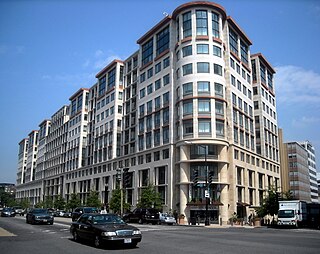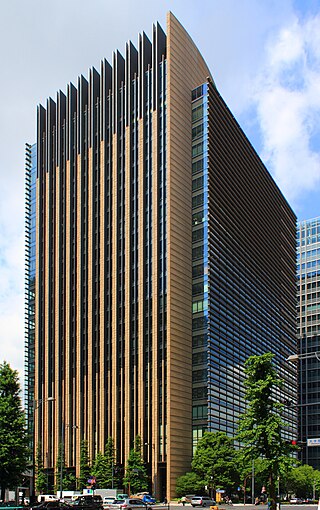
The International Finance Corporation (IFC) is an international financial institution that offers investment, advisory, and asset-management services to encourage private-sector development in less developed countries. The IFC is a member of the World Bank Group and is headquartered in Washington, D.C. in the United States.
Washington Mutual was the United States' largest savings and loan association until its collapse in 2008.
A real estate investment trust is a company that owns, and in most cases operates, income-producing real estate. REITs own many types of commercial real estate, including office and apartment buildings, warehouses, hospitals, shopping centers, hotels and commercial forests. Some REITs engage in financing real estate.
An investment trust is a form of investment fund found mostly in the United Kingdom and Japan. Investment trusts are constituted as public limited companies and are therefore closed ended since the fund managers cannot redeem or create shares.

Sumitomo Mitsui Banking Corporation is a Japanese multinational banking financial services institution owned by Sumitomo Mitsui Financial Group, Inc. It is headquartered in Yurakucho, Chiyoda, Tokyo, Japan. The group operates in retail, corporate, and investment banking segment worldwide. It provides financial products and services to a wide range of clients, including individuals, small and medium-sized enterprises, large corporations, financial institutions and public sector entities. Since 2011, it has been included into the Financial Stability Board's list of global systemically important banks.
A community development financial institution (US) or community development finance institution (UK) - abbreviated in both cases to CDFI - is a financial institution that provides credit and financial services to underserved markets and populations, primarily in the USA but also in the UK. A CDFI may be a community development bank, a community development credit union (CDCU), a community development loan fund (CDLF), a community development venture capital fund (CDVC), a microenterprise development loan fund, or a community development corporation.
Jefferies Group LLC is an American multinational independent investment bank and financial services company that is headquartered in New York City. The firm provides clients with capital markets and financial advisory services, institutional brokerage, securities research, and asset management. This includes mergers and acquisitions, restructuring, and other financial advisory services. The Capital Markets segment also includes its securities trading and investment banking activities.

OneWest Bank, a division of First Citizens BancShares, is a regional bank with over 60 retail branches in Southern California. OneWest Bank specializes in consumer deposit and lending including personal checking and savings accounts, Money Market accounts, CDs, and home loan products. OneWest also offers small business checking, savings, CD and money market accounts as well as small business loans and treasury management products.

Union Bank was an American nationally licensed full service bank with 398 branches in California, Washington and Oregon that was wholly owned by MUFG Americas Holdings and was acquired by U.S. Bancorp. Headquartered in New York City, it had commercial branches in Dallas, Houston, New York and Chicago, in addition to two international offices.
This article provides background information regarding the subprime mortgage crisis. It discusses subprime lending, foreclosures, risk types, and mechanisms through which various entities involved were affected by the crisis.
Regulatory responses to the subprime crisis addresses various actions taken by governments around the world to address the effects of the subprime mortgage crisis.
The Emergency Economic Stabilization Act of 2008, often called the "bank bailout of 2008" or the "Wall Street bailout", was proposed by Treasury Secretary Henry Paulson, passed by the 110th United States Congress, and signed into law by President George W. Bush. It became law as part of Public Law 110-343 on October 3, 2008, in the midst of the financial crisis of 2007–2008. It created the $700 billion Troubled Asset Relief Program (TARP) to purchase toxic assets from banks. The funds were mostly redirected to inject capital into banks and other financial institutions while the Treasury continued to examine the usefulness of targeted asset purchases.
The Troubled Asset Relief Program (TARP) is a program of the United States government to purchase toxic assets and equity from financial institutions to strengthen its financial sector that was passed by Congress and signed into law by President George W. Bush. It was a component of the government's measures in 2009 to address the subprime mortgage crisis.
The Capital Purchase Program or CPP is a preferred stock and equity warrant purchase program conducted by the US Treasury Office of Financial Stability as part of Troubled Asset Relief Program. According to the first congressionally mandated oversight report published by GAO, "[TARP's] primary focus was expected to be the purchase of mortgage-backed securities (MBS) and whole loans... [but] within 2 weeks of enactment... the Treasury announced that it would make $250 billion of the $700 billion available to U.S. financial institutions through purchases of preferred stock." This followed a model initiated by the United Kingdom bank rescue package announced on October 8, 2008.
The Subprime mortgage crisis solutions debate discusses various actions and proposals by economists, government officials, journalists, and business leaders to address the subprime mortgage crisis and broader financial crisis of 2007–08.
On March 23, 2009, the United States Federal Deposit Insurance Corporation (FDIC), the Federal Reserve, and the United States Treasury Department announced the Public–Private Investment Program for Legacy Assets. The program is designed to provide liquidity for so-called "toxic assets" on the balance sheets of financial institutions. This program is one of the initiatives coming out of the implementation of the Troubled Asset Relief Program (TARP) as implemented by the U.S. Treasury under Secretary Timothy Geithner. The major stock market indexes in the United States rallied on the day of the announcement rising by over six percent with the shares of bank stocks leading the way. As of early June 2009, the program had not been implemented yet and was considered delayed. Yet, the Legacy Securities Program implemented by the Federal Reserve has begun by fall 2009 and the Legacy Loans Program is being tested by the FDIC. The proposed size of the program has been drastically reduced relative to its proposed size when it was rolled out.

Beneficial State Bank is an Oakland, California-based community development bank. The bank was founded in 2007 by billionaire philanthropist and former Presidential candidate Tom Steyer and his wife Kat Taylor, to provide loans and banking services to individuals in low wealth communities, including entrepreneurs and existing businesses.
Philadelphia financier Jay Cooke established the first modern American investment bank during the Civil War era. However, private banks had been providing investment banking functions since the beginning of the 19th century and many of these evolved into investment banks in the post-bellum era. However, the evolution of firms into investment banks did not follow a single trajectory. For example, some currency brokers such as Prime, Ward & King and John E. Thayer and Brother moved from foreign exchange operations to become private banks, taking on some investment bank functions. Other investment banks evolved from mercantile firms such as Thomas Biddle and Co. and Alexander Brothers.

The 2007–2008 financial crisis, or Global Financial Crisis (GFC), was a severe worldwide economic crisis that occurred in the early 21st century. It was the most serious financial crisis since the Great Depression (1929). Predatory lending targeting low-income homebuyers, excessive risk-taking by global financial institutions, and the bursting of the United States housing bubble culminated in a "perfect storm".

PacWest Bancorp is a bank holding company based in Beverly Hills, California, with one wholly owned banking subsidiary, Pacific Western Bank. It has 69 branches in California, primarily in the southern and central parts of the state, one in Denver, Colorado, one in Durham, North Carolina, and several loan production offices across the country. The company is in the process of being acquired by Banc of California.







